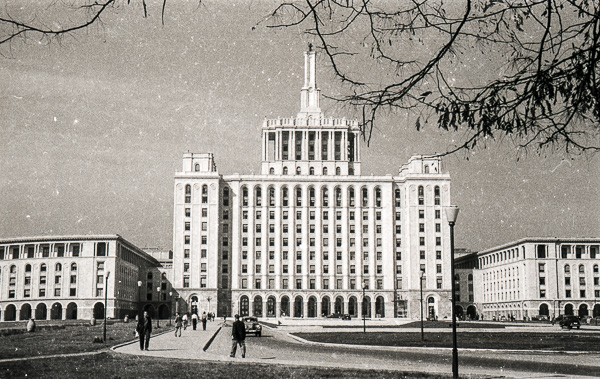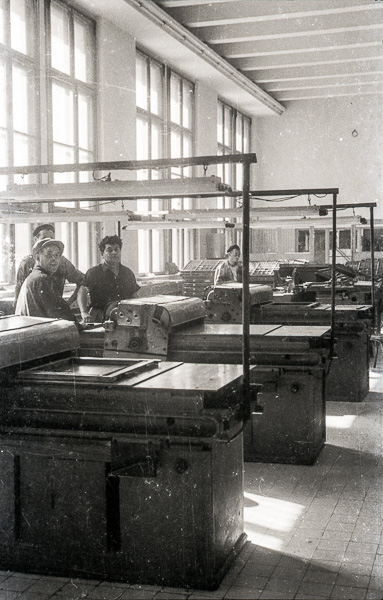Thu 4-Oct-56: Saw Baranga at Institute & heard Aida
Fri 5-Oct-56: Saw Scînteia Printing works [See some current pictures at http://www.flickr.com/photos/cristina_/336794051/ and http://www.flickr.com/photos/38737290@N06/5723590216 ]. Heard Rumanian Folk songs at concert.

Bucharest, Athénée Palace Hotel Friday 4 Oct [5 Oct] 7.30 am
Darling,
The pace is killing me. Yesterday I saw a Mr. Baranga, a director or something of the Institute & through the girl interpreter a program of activities was arranged in which my wishes were to be considered and about where we may get to in the country. What I want to see, etc. Naturally it is to do with the artistic culture – also asked me if I could give a lecture or write a paper, on Australian art. I said I could hardly lecture, but I would try and write something. It was all very cordial, and they expressed the desire for me to enjoy my visit here, and hoped the program was not too strenuous, & if I thought so, please to cut it down. I was to let my interpreter know whatever I wanted – Also they asked could I let them know within a few days when I wanted to return, as plane bookings were very heavy & they wanted to secure me my passage. Well, you couldn’t ask for better treatment could you.






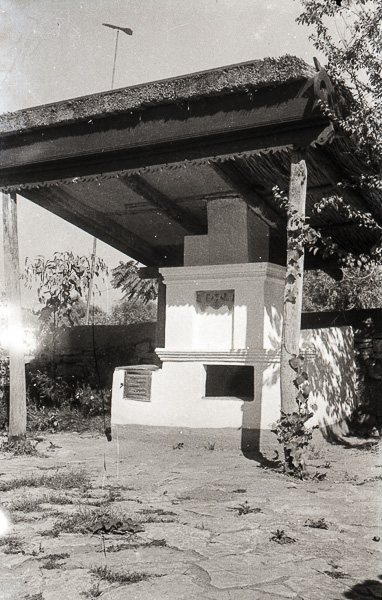

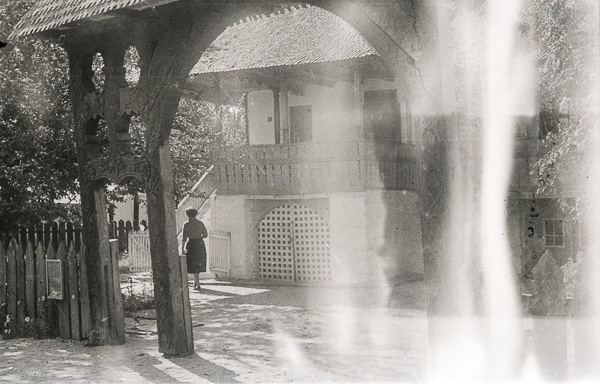

Yesterday, all day, we had a car at our disposal & I was taken around to various galleries. Seems like my time of arrival was inauspicious, as two galleries were closed, being renovated – and the biggest gallery (the ex Royal Palace, which by the way is facing the same square as this hotel) all the best contemporary Rumanian paintings are absent in various European capitals. So we went to the Village Museum. A fine place, set in the big park by the edge of the lake. In this village 32 buildings each from a different area of Rumania (Transylvania, Moldavia, Banat, Cluj regions etc). They have taken down an actual dwelling from these parts & re-erected it in the park. The house, its granary outside & gates & fence – are placed amongst the trees here. The contents also have been brought & clothes, pottery, cooking implements are in place in the interiors. The embroidery, those peasants did was fantastically sumptuous and the pottery lovely in the sturdy peasant manner. It was in the afternoon, after lunch, we visited the Royal Gallery, where I saw the 19th Cent. Work, excepting that they did peasants, whereas we did settlers. That period in art seems quite international. The modern period seems (I mean world wide) to be getting pretty much the same international flavour – except in these red countries where the emphasis seems to be on heroic emergence of the worker – realistic presentation of stirring events, etc – all easily readable to the masses. A visual encouragement – so to speak. After the gallery, Stefania seemed to be flagged out, as the Rumanian custom is to knock off between 1 & 4 or 2 to 5 for a rest from the heat. Factory workers transport etc, caterers of course work through. So from 4 to 6, I trudged the town. Could be very very attractive – but is pretty crumby now. The people are poor, & while consumer goods, in very ordinary quality are there, don’t seem to be able to afford them. The main streets are kept very clean, others, any old how. At 5 the shops opened & I browsed through the books shops, which are very numerous. There is a obvious passion for learning. It is a bit hard to adjust oneself to the fact that these people are only just emerging from a period of great oppression & greater poverty – Only as late as 1907 the peasants revolted & were ruthlessly suppressed. Now they are organising the state alone & I guess it takes time.
At 6.30 p.m. I was whisked off in the car to the opera Aida. Held in a small but fine Opera house. Perfectly intimate like. Opera is on every night except in summer when it is too hot. I don’t care for most of the music in Aida, but this presentation was superb. The décor & settings were really magnificent – done by a Stalin prize winner, a Russian named Cemodurov. Nothing like it will ever be seen in Australia as these settings are not transported all over the country. They are stacked away behind the Opera house. Great statues of the Egyptian Gods. Huge gates with the figure on them in relief, not painted illusion. Different levels – enormous cast behind the principals, good wild ballet work in it – sumptuous costumes colour & lighting. Sweetie, it was quite a spectacle! You know, or have heard of how the Russians can conceive these things. Place packed – yelling Bravo! Bravo! It was sung in Rumanian which is closely allied to Italian.
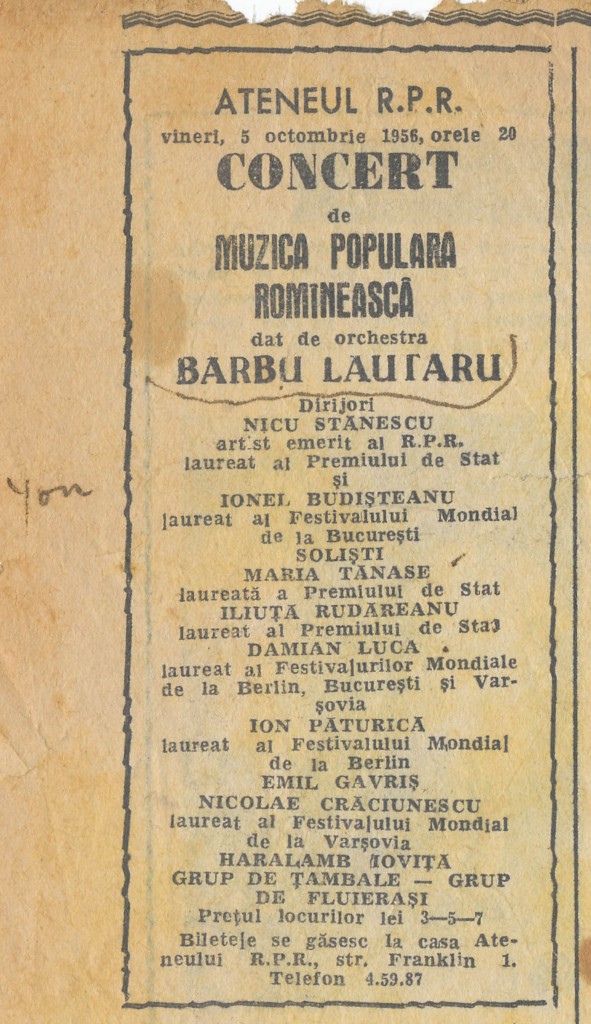
Tonight, I am going to see a concert of Rumanian music & songs. After the opera, we returned to the hotel at 11.15 for dinner. Found it difficult to get a seat, the place was packed. It’s an old Rumanian custom. The orchestra was going full blast – the girl had had it & asked to be excused to go home for sleep – so I had Rump steak sauté Lyonnaise, & crème d’aubergines. The orchestra playing fast as hell Rumanian music got me in. While I was fumbling for a match – the drummer leaped down with a lighter. I must have been obviously interested because the pianist beamed at me. The violinist seems inexhaustible. When at last they finished I gave them the last but 2 of my long Chesterfield cigarettes – there was one each for the 7 of them. They liked that (because these European cigarettes are bloody awful.) The pianist came over & affably spoke to me in English & said they’d play anything I liked. English, American, German, Hungarian, Rumanian – so there! Also today I bought 4 gramophone records of Rumanian music. Farewell for the moment dearest girl.
Midnight – Everything is unreal or very common place. Even the most unexpected things are; when experienced, acceptable without surprise. I’ve just heard a Rumanian & Gypsy orchestra with 50 performers in the loveliest little concert hall [Romanian Athenaeum].

About as wide as the Town Hall but circular, & with the orchestra projecting. It has a dome roof & Parisian spiral marble staircases leading from below up to the seats & boxes, which are all on the same level as the stage. 2½ hours of Rumanian music played by the best in Rumania – Gypsy singers – violinists – pan pipers – cymbalos – all this activity. Without you, to remember it with me. At dinner with a couple of Englishmen (11.30pm) things liven up a bit. This character I met, apparently a supporter, spares no horses in what he charges the proletariat for dinner. The whole thing is like living in a foyer. However, within a few days I hope to make some contact, somewhere. The Rumanians are fundamentally very gracious – as I found out from a pidgin French German English conversation with the lift driver. I am quite happy and am seeing many things of interest. I guess I am missing the home-and-master touch. Your feet wouldn’t stand it anyway. I’m driving the Stefanie girl to the ground – God knows why – I’m doing only half or a quarter of the walking I have been doing over every day since I arrived at Rome. Stephanie is a nice little girl – can’t do enough for you in the way she thinks it should be done – you know, the mother type – reminds me of you – I don’t mind. But one needs a few hours off sometimes. – I met an Englishman tonight – an ex-union executive or something who is studying art in Rumania & living & working here on a sort of extended grant. All very earnest artist – I shall find out if any good.
Went to the Folk Art gallery today – Peasant work – found the Ikons & cake & butter mould carvings more interesting than the embroidery, which is over powering – The density of decoration on their costume stuff is stifling. Wonderful work – but unusable in the modern world.
I could not be looked after better _ I am very comfortable but I miss you – probably need your contact – but must say – so far am too tired even to get an early morning spring – no matter how urgent the call is. I want to talk to you – not listen – I want to see you do your hair over & over again. I want to smell that perfume as I lean over your neck. (Zut! Zut!) I want to see the flowers you have put in the hall – and I want to hear Graham practising in the same old uninspired way. Trellie on the lounge and you bellyaching to Graham in the morning – lay off him will you. What’s it like living without a big blow – top?
Don’t expect too many letters from me from now on – the rate of exchange is loaded against foreign currency. On my travellers cheques a letter airmail to you costs 24/-, so you can understand the graciousness of the Institute in giving me 550 Lei (their unit of currency) to use for pocket money. That cable, I must admit, by mistake, went at full rates – 95 Lei costing about £6. (£5 st = 82 Lei on the open market.)
Enough of problems – It’s only a fortnight since I was about to leave Australia. One is less isolated in the bush in Borneo or New Guinea. Soon I hope to meet some artists and perhaps find something in common.
Lots of love to Graham – I can’t write to him separately – & with my love,
Bill
Şoseaua Kiseleff 3, Sector 1, Bucharest 011341, Romania
Bulevardul Mihail Kogălniceanu 70-72 Bucharest, Romania
Şoseaua Kiseleff 28-30, Bucharest 011347, Romania
Calea Victoriei 49-53, Bucharest, Romania
Bucharest, Romania
1-3 Strada Episcopiei Bucharest, Romania
Strada Benjamin 1-3 Franklin Bucharest, Romania
